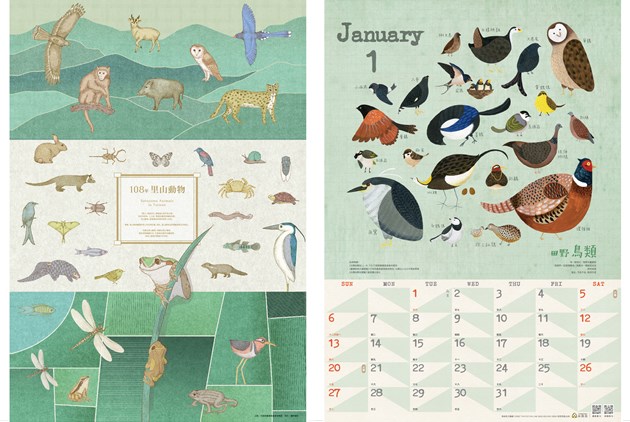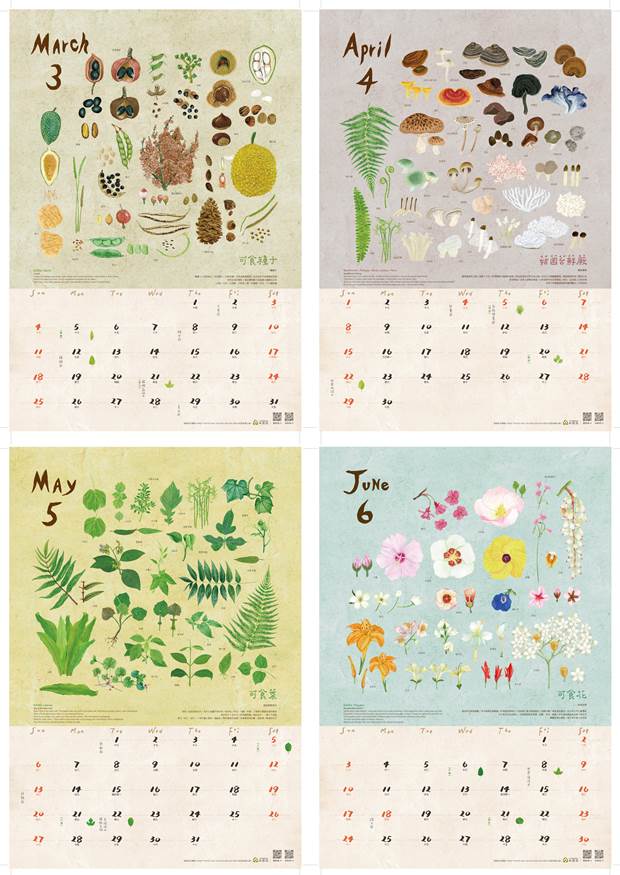How Taiwan’s Forestry Bureau Created Unexpected Buzz with an Artsy Calendar

Source:The Forestry Bureau
The Forestry Bureau used to commission its annual calendar as a promotional give-away to non-government organizations, schools and government institutions. But during the past two years, the calendars suddenly became so sought-after that even urgently ordered reprints were immediately sold out. Few would have guessed that a civil servant was the mastermind behind this successful publicity campaign.
Views
How Taiwan’s Forestry Bureau Created Unexpected Buzz with an Artsy Calendar
By Monica Wangweb only
Planned by the Forestry Bureau and designed by Taichung-based Seedesign, the Native Animals Calendar 2019 went on sale at the Huashan 1914 Creative Park in Taipei in early December. The first print of 3,000 copies, sold in two batches on two days, was sold out by the end of each day.
An urgently ordered second print of 5,000 copies also quickly sold out in online stores. In the run-up to Christmas, people who could not get their hands on the calendar flooded the Forestry Bureau’s official Facebook page with inquiries or urgent comments such as: “I want to buy one!”, “Is it available in Kaohsiung?”, “So many people want to buy it, why don’t you increase the sales volume and sales channels?”
 The Forestry Bureau’s Native Animals Calendar 2019 is already out of stock everywhere (Photo from the Forestry Bureau)
The Forestry Bureau’s Native Animals Calendar 2019 is already out of stock everywhere (Photo from the Forestry Bureau)
It was not the first time the Forestry Bureau created a buzz with its annual calendar.
In 2018, the calendar featured freehand drawings of edible plants, reminiscent of illustrations in a plant handbook. Although the picture book-like Food Forest 2018 calendar was not publicly sold, the Forestry Bureau was flooded with inquiries from people who wanted one. The calendar even became a hot item in China after design influencers on Chinese microblogging website Weibo reposted reports and comments about the calendar.
The Forestry Bureau’s annual calendar has a long history. Originally it was commissioned as a promotional gift for collaborating agencies, non-governmental organizations, schools, neighborhoods and government institutions.
So how did the time-honored calendar suddenly became such a hot commodity? Forestry Bureau Director General Lin Hwa-ching played a crucial role in this story.
“If it wasn’t for the director general, these things wouldn’t have happened. He has a mind of his own; I admire him greatly,” says Gan Ke-ping, design director of Seedesign, who participated in the calendar project.
The mastermind behind the hugely popular calendar, Forestry Bureau Director General Lin Hwa-ching (Photo by Kuo-Tai Liu)
From Food to Animals – Reaching Out to the Public
When Lin took the helm of the Forestry Bureau in 2016, he realized that the calendar, which had been a routine project that followed established procedure for many years, presented an opportunity to reach out to young people.
Past calendars, which had mainly used scenic photographs of mountain forests, had found a loyal fan community. However, Lin thought that a new visual design approach was needed to appeal to new target audiences.
“Calendars are actually a very good policy marketing tool. The Forestry Bureau manages state-owned forests, but what is the significance of national forests for the public? Over the past few years, our policy has always revolved around the value of forest ecosystems for diverse services, but these campaigns were very stiff, so who will listen to you? We needed to come up with a soft approach instead,” explains Lin.
So, the bureau planned the Food Forest calendar in 2018 and in 2019 the Native Animals calendar. Like the Native Animal Train that Taiwan Railway launched at the beginning of the year, the calendar features various animals found in Taiwan.
 Food Forest calendar (Photo from the Forestry Bureau)
Food Forest calendar (Photo from the Forestry Bureau)
The Food Forest calendar was designed with practical use in mind. It presents edible seeds, leaves, flowers, herbs or fungi from the wild in combination with a short poem. The Lishan Animals calendar presents the animals together with an article on their specific habitats. The aim is to help citizens develop a connection to forests and entice them to develop an interest in the ecosystems around them.
Therefore, the Forest Bureau publications must not only be aesthetically attractive but must more importantly provide correct information. The Forestry Bureau asked university professors and experts to serve as consultants to ensure that the calendar content is free of factual errors.
On the other hand, there was concern that if the design looked too much like a scientific handbook, people would be put off. In the public supplier selection process, Seedesign prevailed over the other design workshops because it has been engaged in the research of seasonal foods for a long time, and its designers are good at hand-drawn illustrations.
“We had a hard time while we were making it, constantly revising as drafts went back and forth,” recalls Gan. The Forestry Bureau had strict requirements: Not only were the illustrations supposed to be beautiful, but also true to the plants’ appearance in every tiny detail such as the pattern and direction of leaf veins. The three Seedesign illustrators wholeheartedly delved into studying more than 600 plants, repeatedly re-confirming their drawings with the experts.
On top of its popular calendars, the Forestry Bureau has also released matching nature observation notebooks (Photo by Kuo-Tai Liu)
Teachers Use the Taiwan-Themed Calendars as Teaching Material
Gan points out that the two calendars feature a host of elements that represent Taiwan and are articles for daily use. People feel that the drawings, which feature warm, soft brush strokes, color tones and outlines, are cute.
On the other hand, the calendars were not created by an individual however they saw fit. Rather, the Forestry Bureau’s professional expertise came in to provide the hidden context and logic behind each month’s theme and every single plant or animal. As a result, elementary and junior high school teachers have been using the calendars as teaching material.
Have you read? More on Taiwan's soft power:
♦ This Mechanical Flower Symbolizes Taiwan’s Soft Power
♦ How Taiwanese Design Can Stem the Korean Tide
♦ Taking Taiwan’s Culture to the Runways of London and Paris
On Facebook, Yen Shen-horn, associate biology professor at National Sun Yat-sen University, stated that the Forest Bureau’s calendars have been getting even more awesome over time. He noted that the Food Forest calendar, with its presentation of plants for survival in the wild, wild vegetables, edible seeds, fungi, mosses and ferns, was very interesting and deserves to become a collector’s item.
 The hugely popular Food Forest 2018 calendar (Photo from the Forestry Bureau)
The hugely popular Food Forest 2018 calendar (Photo from the Forestry Bureau)
In the Native Animals calendar, Lin presents each animal from the perspective of a young boy from the neighborhood. Its concept reflects a spirit that allows humans and nature to coexist and thrive together.
By departing from the usual approach of creating animal stars, the authors convey the message that everyone is equally important, which is another reason why the calendar resonated with so many people.
 The 2019 Native Animals Calendar, which is already out of stock everywhere (Photo from the Forestry Bureau)
The 2019 Native Animals Calendar, which is already out of stock everywhere (Photo from the Forestry Bureau)
“While some people may be quite dynamic, we still need to coexist in everyday life. The calendar’s composition reflects life and relates to nature. What appears to be a tiny component actually puts together a very big picture similar to overview pages in an illustrated handbook. Although the calendars talk about plants and animals, they don’t feel preachy,” explains Gan.
Under the headline “The design of old mandarins can also be cute”, the Weibo account of Chinese design website ad518.com praised the Forestry Bureau’s publicity campaign, saying, “These unique and novel forms of publicity convey ecological ideals unobtrusively and imperceptibly, like years of good education. It is worlds apart from rigid preaching.”
Lin is convinced that those in charge of projects in government agencies are able to influence policy and create space for innovation. “As a civil servant, you can see it as just a nine-to-five job, or you can do a brilliant job and leave a legacy of memorable things.”
The Forestry Bureau took advantage of the popularity of calendars in Chinese culture to tell a series of stories about our ecosystem in a warm and charming manner. Gan thinks the calendars are a typical example of knowledge introduction in the era of the autodidact. Noting that the 2019 calendar was only a curtain-raiser, Gan says that, like many readers, she can’t wait to see what the Forest Bureau’s annual calendar for 2020 will look like.
Translated by Susanne Ganz
Edited by Sharon Tseng








